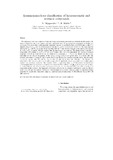| dc.identifier.citation | Nijegorodov, N. & Mabbs, R. (2002) Luminescence-laser classification of heteroaromatic and aromatic compounds, Spectrochimica Acta Part A: Molecular and Biomolecular Spectroscopy, Vol 58, Issue 2, (15 January), pp. 349-361 | en |
| dc.description.abstract | [Please note that the mathematical symbols have not transposed into this abstact].The luminescent and laser properties of heteroaromatic and aromatic compounds are reviewed and discussed on the basis of all possible mutual arrangements of singlet and triplet states. All heteroaromatic compounds are divided into five classes. It is shown that a heteroaromatic compound can only be an effective laser dye if it belongs to class V (a situation where the Tn_* level lies at higher energy than the S__* 1 level). Moreover, it is shown that the energy interval between the Tn_* and S__* 1 states must be no less than 1000 cmâ 1 since the rate constant of the non-radiative process S__*1 _Tn_*_T__1 is usually 100 times greater than the fluorescence rate constant. The classification is extended to compounds with orbitals of _l,_*, _,__* and _l,__* nature. Pure aromatic compounds, the spectral-luminescent properties of which are solely determined by transitions of _-electrons (_ _ _*), are also divided into five classes, depending on the mutual arrangement of the Sp(1La), S_(1Lb), Tp(3La) and T_(3Bb) states. It is found that only aromatic compounds of classes IV and V can be effective scintillators and laser dyes. It is also shown that the energy interval S_â Sp (for class IV) and T_â Sp (for class V) must be no less than 1000 cmâ 1. To illustrate the classifications for heteroaromatic and aromatic compounds, 12 specifically chosen compounds were studied experimentally and quantum chemically. The quantum yields, _ and decay times, _f of fluorescence in aerated and non-deaerated ethanol or cyclohexane solutions were measured. The oscillator strength, fe, fluorescence rate constant, kf, natural lifetimes, _0 T and intersystem crossing rate constants, kST are calculated. The laser ability of each of the compounds studied is tested. The suggested classification schemes can be extremely useful in the quest for effective scintillators and laser dyes among hypothetical heteroaromatic and aromatic molecules, enabling evaluation of these properties for a particular compound using only quantum chemical simulations. | en |

